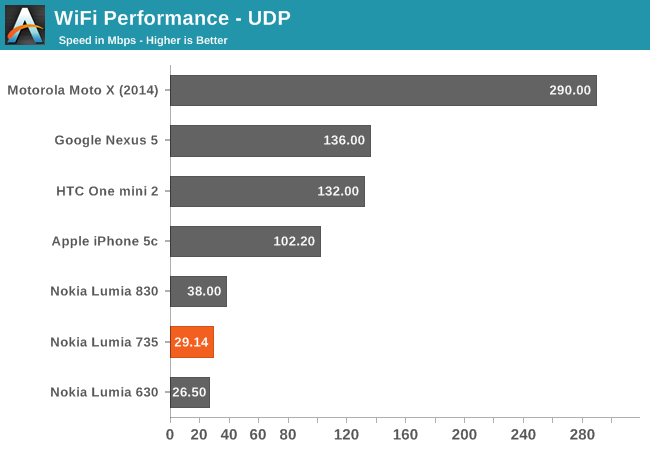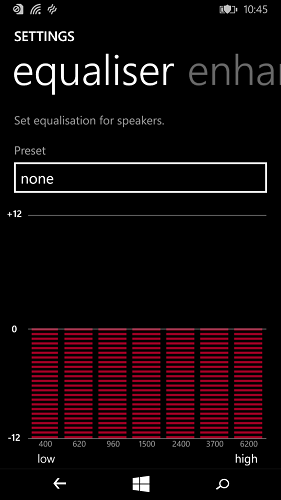Nokia Lumia 735 Review
by Brett Howse on February 3, 2015 6:00 AM EST- Posted in
- Smartphones
- Microsoft
- Nokia
- Lumia
Wi-Fi
Windows Phone does not give us as much access to the hardware as Android, making outright declarations about hardware difficult. However, it is most likely the Wi-Fi solution in the Lumia 735 is the Qualcomm VIVE which is part of the SoC. Unlike the Lumia 830 though, this is a single band only, with one spatial stream. The maximum connection speed is 72.2 Mbps.

Maximum transfer speed that I achieved was only 29 Mbps, which is not fantastic. Many people have faster internet connections in their home, so the 735 will likely not be able to max those out.
Cellular
The MSM8926 SoC supports up to Category 4 LTE, which offers a maximum of 150 Mbps download and 50 Mbps upload, depending on tower traffic, provider hardware, and location of course.
The model shipped for review can support GSM at 850 MHz, 900 MHz, 1800 MHz, and 1900 MHz, along with WCDMA Band 1 (2100 MHz), Band 5 (850 MHz), and Band 8 (900 MHz). LTE FDD is on bands 3 (1800 MHz), 7 (2600 MHz), and 20 (800 MHz). In North America, the main LTE band is band 4, which is not available on this sample to allow LTE speed testing.
GNSS
Qualcomm’s IZat Gen8A is the GPS in the Snapdragon 400 SoC, and as with most modern Qualcomm location solutions it is fast and accurate. With location services enabled on the phone, GPS lock happened within a couple of seconds. Going from location services disabled to a GPS lock took around thirty seconds, which is pretty good.
The Lumia 735 supports A-GLONASS, A-GPS, BeiDou, and assist from cellular and Wi-Fi networks to get a quicker location fix.
Speaker
The Lumia 735 has a single speaker on the back of the device, which reduces bezel sizes but does not give you the optimum location for a speaker. The maximum SPL playing music is around 81 dBA, and the sound quality is as expected not fantastic, with very little low range and a very tinny sound.
If you are to play music on this device, it would be best to do it through either headphones or a Bluetooth speaker. It does have a graphic equalizer, which can be used for the internal speaker or headphones.
Due to technical issues, I am unable to do a recording for call quality at this time.













64 Comments
View All Comments
Brett Howse - Tuesday, February 3, 2015 - link
The Glance screen app is only available to phones with the correct hardware to use it unfortunately. Would be nice if it was just an app.noblemo - Friday, February 13, 2015 - link
The slow Wi-Fi means disabling your 5GHz radio or upgrading to an access point with simultaneous 2.4/5GHz coverage. I ran into this issue when I bought a Lumia 635 as a house phone. Now I have to run my laptop and Icon on congested 2.4GHz when no one else in the area is running 5GHz. First World problem, but still annoying.nathanddrews - Tuesday, February 3, 2015 - link
In all honesty, I'm waiting to upgrade my S3 to an Intel-X86-powered, Windows 10 phone. We're almost there.http://makeameme.org/media/created/almost-there-al...
juan96 - Tuesday, February 3, 2015 - link
For display test, I know that Anandtech uses Calman SW and i1Pro for measuring . But I curious, how they input test pattern to cell phone? As anybody knows, MicroUSB port of cellphone is output only.deltaman - Tuesday, February 3, 2015 - link
Actually, Lumia phones DO support transferring data in BOTH directions via the micro USB port; the phone mounts like any other USB storage device when connected to a Windows machine, & M'soft offers a free utility for file transfers to/from Mac OS devices...juan96 - Tuesday, February 3, 2015 - link
Yes, I misunderstood. MicroUSB is not only for output. But I still didn't find the solution to use Android tablet uses as display device like monitor.tipoo - Tuesday, February 3, 2015 - link
With 720p and MicroSD thrown in, it could be a decent Moto G competitor. I wish they at least upgraded to the Snapdragon 410 though.tipoo - Tuesday, February 3, 2015 - link
It's pretty silly how poorly the WP browser does against the equivalent SoC in an Android phone. Sunspider is the only thing it does well in, and we know Microsoft targeted that for optimizations, making it less of a real world result. They don't even have a terrible rendering engine on the desktop side, so I don't get why they continue to underperform so much on the mobile side.tipoo - Tuesday, February 3, 2015 - link
And the GPU too, what is with that?Brett Howse - Tuesday, February 3, 2015 - link
This will finally be resolved when Spartan is the new browser in Windows Phone 10. Not that this is any excuse for the poor implementation now, but finally, browser performance seems to be a priority.